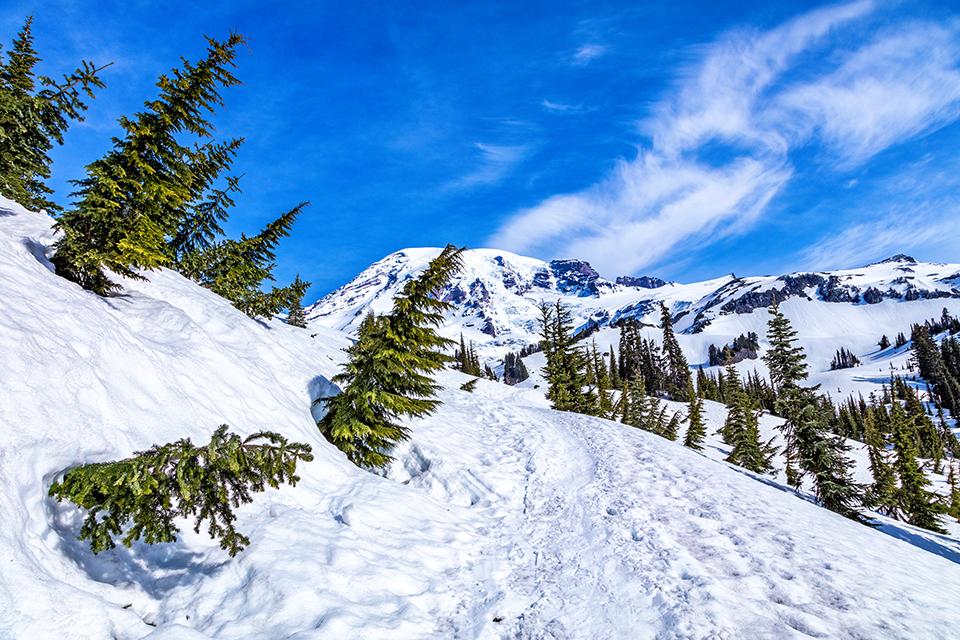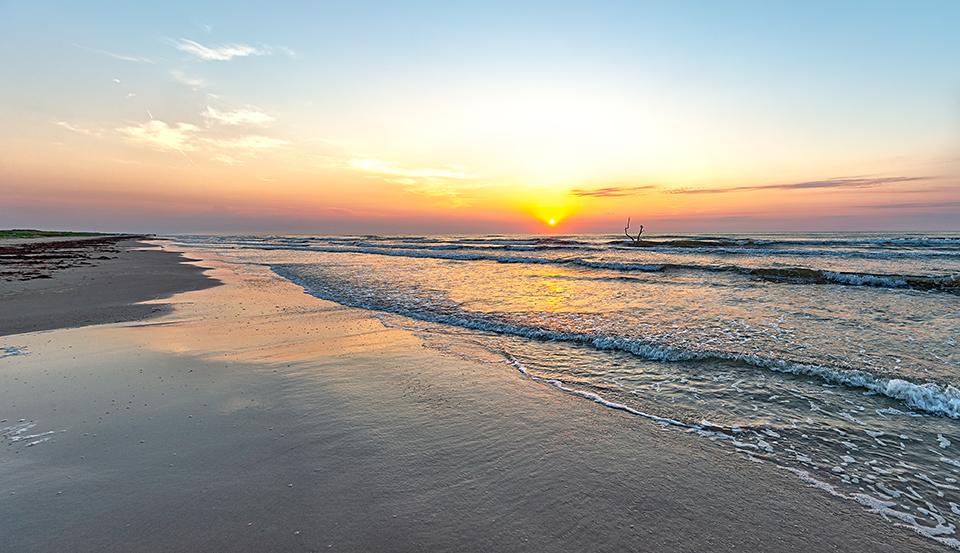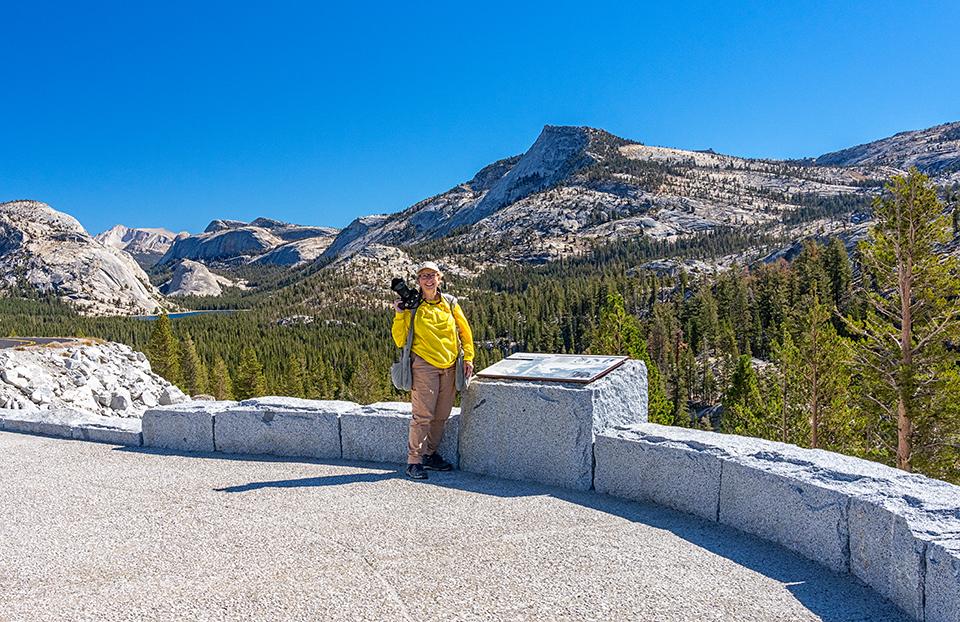
Hiking up the Bristlecone Grove Trail, Great Basin National Park / Rebecca Latson
The other day, I chanced upon a Facebook post by the National Park Service about being prepared and knowing your limits during a trip to a national park. I thought I’d incorporate what I read in that NPS post into this final photo column of 2021, since it was such a great post and gave me pause for reflection regarding how much I plan for a photo trip and what my own limits are when I go out by myself. As I’ve aged, my attitude (and my joints), have imposed limits to where and how I hike with my cameras that I would not have given second thought to when I was younger.
So, to quote that NPS post: “You've decided to take a trip to a national park either alone, with your friends, or maybe you somehow ended up as group leader. Do you know what information you should research and what skills you should practice before you head out? Today’s topic: Know Your Limits! Things to keep in mind.” Note: depending upon whether you are alone, with friends, or are a group leader, there will be more planning and preparedness because it’s not just about you but also those for whom you may be (or feel) responsible.
Time of year: the NPS asks “during what season will you be doing your activity? Oh, you’re headed to bear country? That salmon scented body wash was a bold choice.”

Autumn color at Paradise, Mount Rainier National Park / Rebecca Latson

The colors of winter at Paradise, Mount Rainier National Park / Rebecca Latson

Blue sky and snow in the spring at Paradise, Mount Rainier National Park / Rebecca Latson
You’ll see and photograph so many different things with each season – often the very same spot will yield different photo ops, depending upon the time of year. Regarding those seasonal changes, when you travel to a park unit, are you prepared weatherwise? What kind of rain/snow gear are you packing for yourself and your camera? Have you researched the park(s) to which you are traveling? Spur of the moment trips may be adventurous, but they can also be slightly risky if you don’t have it all together. A little research never hurts, and you’ll have a better idea of what to expect, as well as how to prepare for the unexpected.
What are you planning to do with your camera on a national park trip? Focus on wildlife, landscapes, or a little bit of both? What you plan on doing will determine your lens choice if you use an SLR camera. Point-and-shoot and smartphones come already equipped with telephoto and wide-angle settings.
And yeah, best not to wear any cologne, aftershave, scented deodorant, perfume or other fragrance when out in the parks. Seriously, not only will you not be able to smell the sweet scents of nature (pine, sage, cedar, fresh air, rain), but neither will the person with you or passing you on the trail. Who wants to smell Chanel No. 5 or Old Spice while hiking the Great Outdoors? Not to mention, you’ll be a great calling card for that large wildlife predator curiously checking you out as a possible meal. According to the National Institute of Environmental Health Sciences, “a bear’s sense of smell is seven times better than a blood hound’s, or 2,100 times better than a human’s.”
Setting: The NPS asks if your activity takes place “at the beach, on a trail, in a cave, on a mountain, future hospital room, or a historical site? Choose wisely.”

A windy summer day at Rialto Beach, Olympic National Park / Rebecca Latson

A calm summer sunrise over Malaquite Beach, Padre Island National Seashore / Rebecca Latson
Even in the summer, a light jacket makes sense while walking the windy beaches at Olympic National Park in Washington state. A t-shirt, on the other hand, works just fine for a photographic stroll on the miles of beaches at Padre Island National Seashore in Texas. Before setting out for a photographic day on the sand, make sure your camera is protected from those wind-blown gritty grains as well as the salt air. SLR users, try not to change your lenses unless your camera is sheltered from the elements. Sand grains lodged in your camera’s or lens’ internal workings make for a less-than-perfect photo day at the beach. Remember to wipe down your camera and lens with a damp cloth once you return to your lodging to remove any salt air residue.

Shining light on the speleothems in Lehman Caaves, Great Basin National Park / Rebecca Latson
Oh, and if you are in a cave, like Lehman Caves of Great Basin National Park in Nevada, Wind Cave National Park or Jewel Cave National Monument in South Dakota, Carlsbad Caverns National Park in New Mexico, or Mammoth Cave National Park in Kentucky, you’ll want to bring a light jacket or sweatshirt for yourself (cave temps are usually in the 50-degree range), sturdy footwear to prevent slips and slides on the damp floor, and perhaps a microfiber cloth to wipe condensation from your glasses and camera lens, since caves tend to be a little bit humid.
Duration: The NPS wants to know “Will your trip or activity last a few hours or all day? Oh, it’s a little chillier than you thought?”
Whether you choose to set out on a day hike or multi-day backcountry jaunt, take a little extra clothing, including a hat. If you’re going to be away from cabin or camper for a period of time, carry plenty of spare memory cards and camera batteries with you, too, and maybe a protective rain covering for your camera. High elevation weather can change on a dime, from sunny blue skies to gray clouds spitting rain, sleet, or snow. The scenery may be photographically dramatic but the elements might create havoc with your camera equipment.
Even for a short hike, take plenty of water and snacks. I saw one tall guy on the Stella Lake trail in Great Basin National Park carrying a half-filled 12-ounce bottle of water and nothing else. That’s a bit measly, even for a short summer hike (less than 3 miles). High elevation and little moisture in the atmosphere contribute greatly to thirst. I’ve never experienced the really serious side effects of dehydration (intense thirst, dizziness, rapid heartbeat, confusion, fainting), but I have entertained a dehydration headache because I was stupid enough not to have brought more water with me.
Some of those snacks you pack along should be salty to replace lost salts from sweat and drinking too much water. Hyponatremia can be as serious as dehydration. There’s a fine balance in staying hydrated and healthy on the trail, isn’t there?
Difficulty level: The NPS asks “will you be going a short distance at a slow pace, on flat terrain or a long distance at a faster pace on difficult terrain? When will you arrive?”
Knowing your limits means you shouldn’t push yourself if you don’t feel safe about it or are not in shape to do it. I’m not the most surefooted of hikers, so I tend to hike at a more leisurely pace, often stopping to observe my surroundings. I’m definitely not one of those people who keep their heads down while plowing along the trail from Point A to Point B to arrive at their destination in as short a time as possible. Instead, I’m what you’d call the “old cow’s tail,” because I’ll always be the last in line on a trail (yeah, yeah, and the first to be eaten by a bear). I also tend to carry a hefty camera pack because of my “everything but the kitchen sink mentality.” Understanding these limits to my hiking ability means I generally choose the shorter hikes. Doesn’t mean I don’t capture some awesome shots but it does mean I want to make it back to my room in one, uninjured, piece. My mantra has always been to take it slow and really see my surroundings.
I travel solo, so I always let my family know when I arrive at the park and where I will be on a given day – if there’s cell or internet service. I’ll also have left a list with family of where I will be lodging, when I’ll arrive there, and when I will depart.
Skill level: The NPS asks “Do you have a very particular set of skills? Skills that you’ve acquired over a very long career? For example, ask yourself if you need special skills (e.g. rock climbing, bird identification, walking into a spider web and instantly releasing your inner ninja) to safely enjoy an activity?”

It takes a little skill to tackle El Capitan's granite walls, Yosemite National Park / Rebecca Latson
I enjoyed photographing climbers scaling the sheer rock face of El Capitan in Yosemite National Park in California, but I certainly don’t have the skill (nor the desire) to do that, myself. My particular skill set deals with operating my camera in a way to capture the best possible photo of my national park subject. That means I know how to use my camera’s settings to achieve that goal. You should also know how to use your camera before you set out on your park journey. I can tell you from past experience just how much valuable picture-taking is wasted because of trying to figure out a particular setting on a new camera.
One last thing regarding preparation: be prepared to pack out what you pack in. That includes orange and banana peels. Wait, aren’t fruit peels biodegradable? Yes, but it takes forever for them to break down and they really aren’t good for an animal’s digestive system. To that end, maybe you ought to stow a trash bag (and perhaps a rubber glove or two for touching the trash) in your pack to collect trash left by those unenlightened humans who don’t practice Leave No Trace principles along the trail. I carry a bag in my photo vest, which I then hang off of one of my camera vest pocket buttons when I start to fill it with trash. I’ve packed out fruit peels, masks, face tissues, hats, and even fabric napkins.
You can learn more hiking safety tips at https://www.nps.gov/articles/hiking-safety.htm.
Ok, time for me to stop typing and start my own research for next year’s planned national park photo trips. See you on the trail in 2022, Travelers!

The author at Olmsted Point, Yosemite National Park / Rebecca Latson




 Support Essential Coverage of Essential Places
Support Essential Coverage of Essential Places







Comments
As always Rebecca, an insightful and helpful article! Thanks again! And Happy New Year to you.
Thanks so much, Chip. I hope you have a Happy New Year, too!